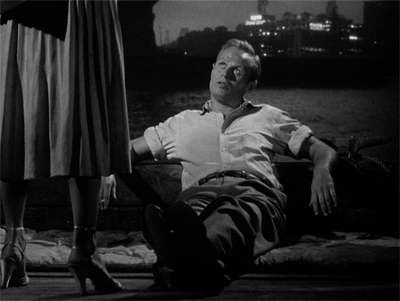A part of this viewing list: Criterion Collection Spine #224: Samuel Fuller’s Pickup on South Street.

I first saw this in a film noir class I took in college, That same week we watched Kiss Me Deadly, so I got a bit confused and thought this film involved Mike Hammer and ended with a nuclear bomb. Woops. Definitely shame on me for misplacing my memory of this sharply complicated but nevertheless deft little film. The most immediately striking aspect of this film is the dialogue. Overflowing with the argot of ’40s small-time crime, the New York presented in this film is markedly different from most portrayals. Like the characters themselves, most of the action takes place on the fringes of the city; the waterfront or underground in the subway. Spaces are small, crowded, claustrophobic, in typical noir fashion.
Also in typical noir fashion, everyone smokes all of the time and most of the action takes places at night. But Fuller inverts some of the other items on the noir checklist. The protagonist, while still anti-heroic, is not destroyed by his ambition, and although the female lead, an implied ex-prostitute, starts off this trouble, she is more femme sauveur than femme fatale. In addition to these inversions Fuller adds in a hefty dose of Red Threat that has echoes in Shock Corridor ten years later. The casting was spot on and the acting excellent, which coupled with the plot, is why this film is a staple of film noir.
As a side-note: my favorite trick in this film was Fuller’s constant emphasis on what was not on screen; typically bound to entrances involving Skip and how observant he is. He enters a room, glances around, completes some action [most notably the lighting of two cigarettes] and then the camera follows him to reveal what caught his notice [usually Candy].

The plot centers around Skip McCoy, a cannon fresh from the clink, who binges a dame named Candy of her pocketbook on the subway and unknowingly ruins a government sting operation. He’s stolen some microfilm containing secrets that would lead the government to “Mr. Big.” The police call a stool pigeon to identify Skip and give a lead on his whereabouts. Meanwhile, the commies are also trying to track him down to reclaim the microfilm. Candy and Skip get caught in the middle of this power play and it turns out the Candy isn’t a commie, just their pawn. There are a few brutal scenes of violence against Candy and plenty of loose morals, so I doubt the film would have been approved without the strong nationalistic flavor. It could be argued that Candy and Moe get what is coming to them, the former for consorting with communists, the latter for being an informer, but Moe’s murder is more martyrdom than punishment. She’d inform on anyone to anyone except a communist.
It is important to note that Skip McCoy doesn’t fight the commies out of a sense of nationalism, [“Don’t wave the flag at me.”] but because he finally realizes that Candy loves him. So it is strange to see that he is not affected at all by the maelstrom he’s found himself in. Perhaps because he’s such a slim customer, with a cock-eyed smartass smile that embodies a certain idea of American pugnacity all this drama is expected to roll off his back. Well, it does, and he is the man, not the cops or the feds, who ultimately breaks up the commie plot and captures Mr. Big, all thanks to his skills as a pickpocket.
The resounding message is that while some Americans may be enemies with each other in civilian life, when a threat to the nation appears, they’ll work together to defeat the damn dirty commies. Just another type of exploitation cinema for your viewing pleasure.

• Criterion Essay by Luc Sante.
• Essay by Grant Tracey.
• Bright Lights Film Journal with a great article putting the film in a cinematic context.
• Senses of Cinema article by Richard J. Thompson.
• Moe versus the Commie. Excellent clip from the film on Youtube.